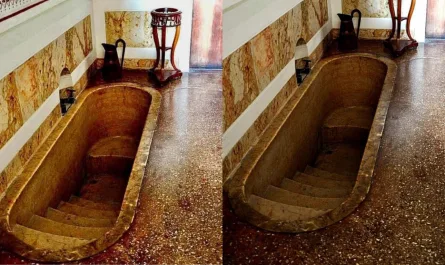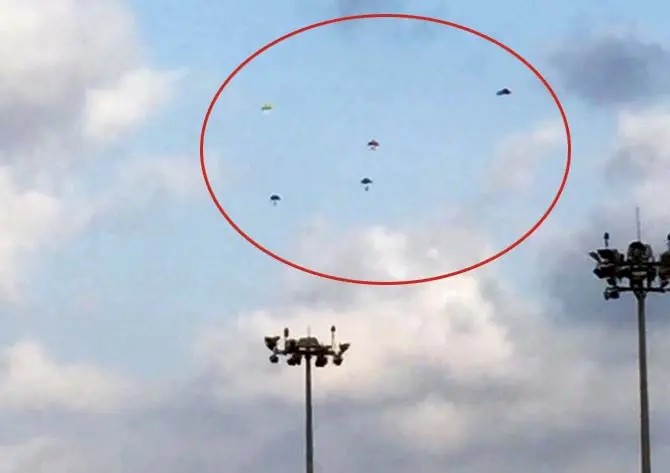R-14 Under Way, Under Sail
While at sea off Hawaii in search of a lost vessel in 1921, a U.S. submarine was nearly lost herself when she ran out of fuel. The sub’s innovative captain devised a unique solution— he would sail her home.
By Lieutenant Commander Robert G. Douglas, U.S. Navy (Retired)
The young acting commanding officer, Lieutenant A. D. Douglas, sat on the bridge of the disabled submarine thinking about his predicament. The boat was about 100 miles southeast of the island of Hawaii, with no means of propulsion or radio communication and only a four-day supply of food and fresh water remaining. Because they were out of the normal shipping lanes there was little chance of help from a passing ship. It was mid-morning of 12 May 1921, a fine, clear day with a slight east wind.
Ten days earlier, Douglas and the third officer, Lieutenant R. T. Gallemore, and a full complement of 30 enlisted men had taken the 186-foot, 680-ton submarine to sea, on the surface, as part of a search group consisting of several Navy ships of various types. Their orders were to search for the USS Conestoga (AT-54), a fleet tug from the mainland, which was overdue at Pearl Harbor. The submarine, the USS R-14 (SS-91), had been assigned a search sector 30° wide in a direction approximately southeast from Diamond Head.
It was tiring duty for the two officers, who had to stand alternating—and sometimes consecutive—four-hour watches on the bridge as officer of the deck in addition to their regular duties. The R-14 normally had a complement of three officers. Like the other search ships, she had put to sea on short notice. It was simple but monotonous duty, back and forth on ever-in- creasing legs as the search sector widened with distance from Diamond Head. She had left port with fuel, provisions, and fresh water for 14 days.
By 12 May, she was dead in the water, a motionless speck on an empty ocean, and had been that way since late afternoon of the previous day, when the diesel engines had stopped. At about the same time, the radio transmitter had failed (not an unusual occurrence then), so the boat was also without communications to shore.
When the engines had stopped, Gallemore, the engineering officer, and his men found that the diesel fuel oil was badly contaminated with seawater, a problem that had appeared intermittently and temporarily during the preceding two days. Despite working around the clock, while the captain continuously manned the bridge as officer of the deck, they could neither prevent the contamination nor purify enough oil to run the engines for more than a few minutes.
“Permission to come on the bridge,” asked Gallemore from the foot of the access ladder.
“C’mon up, Roy,” replied the captain. “Any luck yet?”
“No sir, and we’ve done everything we can think of,” replied Gallemore, who then described his efforts in detail. The news was bad, but the captain did not appear too distressed about it. His mind had been working while he sat on the bridge all night, and he thought he had a solution to their problem.
He had wisely given orders the previous day to conserve electricity by turning off all unnecessary lights and machinery—including the cook’s electric oven and ranges—to minimize the drain on the main storage battery. There was not enough charge in the battery to run even one of the two propulsion motors for 100 miles, and he wanted to save what charge there was for use later. Some machinery had to be kept running, such as the auxiliary generator that provided electricity for the gyro compass, necessary lights, and the radio receiver and transmitter that were being repaired. Douglas also had given orders to conserve fresh water, beyond the normal restrictions on the use of that precious commodity, and to waste no edible food. With no oven or range available, the cook could serve only cold food.
When the engineer finished his disheartening report, he asked, “Any ideas, skipper?”
“Yes, Roy, I do have an idea,” the captain said with a little smile. “We’re going to sail her to Hilo.”
The concept of sailing seemed startling at first, but it was in fact the only course open to the stricken boat. Douglas, who had spent the past 12 hours as officer of the deck, had worked out the details during that time. A quiet, self-effacing man with black hair and blue eyes, he was a problem solver. Just shy of his 27th birthday, he had graduated from the U.S. Naval Academy in spring 1917, served during World War I for nearly two years on the destroyer USS Flusser (DD-20), and then supervised the decommissioning of that ship in Philadelphia after the war. During that period he courted and married an old friend from high school and later attended the recently founded Submarine School in New London, Connecticut, after which he was assigned to the R-14 in Pearl Harbor in April 1920.
By the time his boat was adrift in the waters of the Pacific a year later, therefore, Douglas had had only four years of experience as a naval officer and barely more than a year in the fledgling and dangerous submarine service. He was a full lieutenant and second officer of the R-14, as well as the navigator and torpedo and ordnance officer. For this search mission, because the commanding officer, Lieutenant V. A. Clarke, was not available, he was designated acting commanding officer.
Douglas’s plan for sailing the R-14 was simple. He would have a foresail made of “twelve hammocks sewed together (two deep by six long),” as the boat’s logbook recorded it. He would use for a mast the strong steel king post of the torpedo-loading crane, which fitted into a socket in the deck forward of the bridge. Last, he ordered a “top boom” made “by lashing five pipe bunk frames end to end.” A bunk frame was about six feet long. (In fact, as the after sail in the photograph shows, the boom frames were overlapped for stiffness.)
The crew began work on this project at 0930, and by about 1230 the job was done. The king post, which was a thick-walled steel pipe about eight inches in diameter and about eight feet long, was snugly shipped in its socket. The heavy and ungainly hunk-frame boom was tied firmly to its top, and the canvas sail, about 25 feet wide and 6 feet high, was hung from the top boom. When the sail was in place, the captain ordered the boom swiveled until the sail caught the wind and pulled the bow around toward the northwest. Soon he had the sail set at the proper angle on a starboard tack for steering course 320° for Hilo.
The R-14 had become a sailboat, rigged like an 8th-century Viking ship, and she was moving. Her speed, which was calculated by dropping a can overboard and timing its movement from bow to stern, was one knot. And she was responding, though slowly, to the rudder. For the next 64 hours there would be thumps, creaks, and snapping sounds as the improvised foresail varyingly filled and emptied.
Seeing that the foresail worked, the captain ordered a mainsail made of six blankets, “three wide and two high.” At 1845, this free sail, with sheets at all four corners to keep it spread and set, was “swung to the radio mast,” which was a tall steel post, looking somewhat like a periscope, at the after end of the bridge superstructure. With two masts and two sails, the R-14 increased speed to about one-and- a-half knots.
The captain knew his improvised sails would not withstand a strong wind, and he knew he could not allow men on deck in any but the calmest weather, but with a sail rig men were necessary on deck to tend the sails, day and night. So he was grateful for the good weather and gentle wind, and he hoped both would remain that way.
At 1000 on 13 May, the logbook recorded, “Sighted Cape Kumukahi, Hawaii, three points on the port bow.” From that time on, the boat’s heading was governed by the bearing on that cape.
Immediately after that sighting, the impatient captain ordered a third sail, a mizzen, made of eight blankets, “four wide and two high,” and another bunk-frame top boom from which to hang the sail. This time the mast was the other part of the torpedo-loading crane, a solid steel boom longer and thinner than the king post, and it was installed firmly in the deck aft of the conning tower. The mizzen was set at about 1430, and it raised the estimated speed to two knots. The weather remained fair and the wind friendly.
With the sighting of the cape and the setting of a third sail, everyone’s spirits lifted, but their bodies were tired. It had been all-hands work to make and rig the sails, and their use had made it necessary to have additional sail-tending watches topside.
With 12 hammocks, 10 bunk frames, and 14 blankets topside catching the wind, the crew below had limited sleeping accommodations. Hot bunking was necessary. Most had to sleep on the walking decks; no sleeping was allowed topside for fear of losing a man overboard.
The next day, 14 May, the boat met an opposing current of one knot, which unfortunately reduced her own speed. Although Hilo was then only 25 miles away, it would be another day at the same sluggish speed before the R-14 would arrive there.
At about midnight on 15 May, the wind reversed suddenly, requiring the sails to be changed to a port tack. With the west wind came fog and intermittent rain, resulting in that loss of visibility so dreaded by vessels at sea in the days before radar. These conditions lasted varyingly for about four tense hours. In rare clear moments the lights of the island could be seen to port, and the boat could sometimes roughly establish her position from these. Fortunately, the opposing current diminished slightly during this midwatch.
At about 0430, the sky began to lighten in the east, and the island and the port slowly became visible, again raising the spirits of the crew.
At about 0530, the captain ordered electric propulsion on the battery, at slow speed, first with the starboard main motor and propeller, then with the port. Seeing that propulsion and maneuverability were satisfactory, he had the sails struck and continued under power toward the port entrance, having by then been under sail for 64 hours. Moments later the radio shack reported contact with submarine headquarters in Pearl Harbor, so the captain sent a message briefly describing the events of the previous four days and requesting fuel and provisions.
At 0945, the R-14’s log states, “secured alongside the Matson Line Pier. Took 600 gallons of fresh water aboard.” The next morning, 16 May, the submarine R-12 (SS-89) moored alongside and transferred fuel and provisions, and later that morning both boats got under way and arrived at Pearl Harbor the next day.
The Conestoga, with 56 officers and men on board, never was found and was declared officially lost by the Navy on 30 June 1921.
The voyage of the R-14 was a notable feat of seamanship, even with the good weather throughout. It is unique in the history of submarines. Certainly Douglas’s division commander, Commander Chester W. Nimitz, considered it a job well done, for he gave Douglas a letter of commendation, praising his “initiative and ingenuity.” Perhaps Douglas should have received something more than that letter, welcome and valuable as it was. My opinion, however, is somewhat biased, because that commanding officer of long ago was my father.





